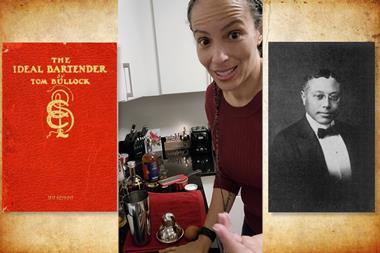Depending on taste, this divisive drink is delicious, disgusting… or deadly
While eggnog has a ‘love it or hate it’ reputation, a 2021 US poll found that it beat out gingerbread, peppermint, and pumpkin spice as a favourite festive flavour. A quintessential US eggnog recipe of eggs, milk, nutmeg, sugar, brandy and rum can be found in the 1917 book The Ideal Bartender, written by libation legend Tom Bullock.1 The first Black American to publish a cocktail guide, Bullock’s beverages were the stuff of legend. His book demonstrates the popularity of eggnog with a single glass recipe and multi-gallon scale-up.
Eggnog – like its medieval British beverage antecedent the posset before it – was once considered luxurious because of the pricey ingredients used to whip it up. These beverages were also considered treatments for a range of ailments. This rich history is why they were often accompanied by a toast to prosperity and good health. But rather than wealth and long life, for two families in the first half of the 20th century, eggnog brought scandal and death.
Waylaid by Waite
The September 1915 wedding between Arthur Warren Waite and Clara Peck appeared to be a fairy-tale romance between a successful US dentist and the debutante daughter of Michigan tycoons John and Hannah Peck. Like many fairy tales, this one twisted toward tragedy. Within a year of the wedding, Waite was describing himself as ‘the worst scoundrel on the face of the earth’.2 This self-flagellation was reasonable as Waite had attempted to secure the Peck family fortune through marriage, monetary malfeasance and murder.
Both of Clara’s parents had died within six weeks of each other in the New York home she shared with Waite. Waite arranged for Hannah’s remains to be cremated, while his attempts to do so with John’s were thwarted. The suspicions of Clara’s brother Percy had been raised – in part because of a mysterious telegram he received advising him to ‘demand autopsy’. Percy did just that, relating to the autopsy doctor that Clara recalled how their father became ‘deathly ill’ after drinking eggnog.2
Eggnog season is often accompanied with fears of Salmonella, but the postmortem evaluation of John’s remains revealed that arsenic poisoning brought about his death. Investigators found arsenic in the Waite home. Documentation of other purchases by Waite revealed that it was not his only weapon of choice. Passing himself off as a research scientist, Waite secured cultures of typhoid, pneumonia, diphtheria, influenza, meningitis, anthrax and tuberculosis. He admitted to exposing John, Hannah and Clara’s aunt Catherine to a biological arsenal to disguise murder as a lethal infection. Waite’s parents-in-law were marked for death so Clara’s inheritance would materialise faster, while he actively conned and stole from Catherine while poisoning her. Clara was not spared, becoming seriously ill. Blood tests would reveal the presence of both typhoid and anthrax, with Clara surviving after extended care. Waite made a series of confessions and was convicted of murdering John.
Calamity by Creighton
Within 20 years of Waite’s wickedness, Mary Frances (‘Fanny’) Creighton became front page news with a string of disturbing crimes.3,4
Creighton could have been likened to Lady Macbeth and her poisoned possets. Instead of conspiring to kill a king, Creighton targeted her housemate Ada Applegate. Their shared New York home was packed as it housed Creighton, her husband John and their two children, along with Ada and her husband Everett. This type of living situation was not out-of-the-ordinary in the Great Depression.3 What was extraordinary is a possible factor in why Creighton killed Ada – so Everett could marry Creighton’s daughter, whom he groomed and abused. In addition, Creighton and Everett were reportedly having an affair.
The toxicity of the Creighton–Applegate home turned deadly when Creighton dished up a glass of eggnog for Ada, who had been sick in bed for a few days. Everett allegedly helped his ill wife down the drink. Ada was declared dead the next morning, with her pre-existing health conditions thought the cause. That changed when investigators learned that, like Ebenezer Scrooge from A Christmas Carol, Creighton was haunted by three spirits – except hers were all from the past.
Creighton was suspected of killing her brother, mother-in-law and father-in-law over a three-year period over a decade before Ada’s demise. Arsenic had been detected in specimens from the remains of her brother and mother-in-law, leading to Creighton’s nearly back-to-back trials and acquittals. This backstory prompted close scrutiny by investigators and forensic analysts after Ada’s death, leading to a third trial that ended in a conviction – for both Creighton and Everett.
The many facets, twists, and turns of Creighton’s case are detailed in Deborah Blum’s The Poisoner’s Handbook, while Waite’s are laid bare in Tobin T Buhk’s Poisoning The Pecks of Grand Rapids. Reading of these malefactors is not merry, so set aside time to whip up a favourite eggnog recipe or give this polarising potable another try. ’Tis the season, after all!
To follow Tom Bullock’s eggnog recipe and to learn more about his story, visit rsc.li/Eggnog
References
1 T Bullock, The Ideal Bartender. DigiCat, 2022
2 T T Buhk, Poisoning the Pecks of Grand Rapids: The Scandalous 1916 Murder Plot. Arcadia Publishing, 2014
3 D Blum, The Poisoner’s Handbook: Murder and the Birth of Forensic Medicine in Jazz Age New York. Penguin, 2011
4 M Gado, Death Row Women: Murder, Justice, and the New York Press. Bloomsbury Publishing USA, 2007

















No comments yet